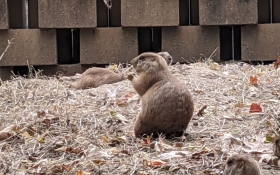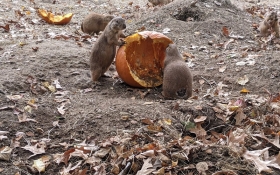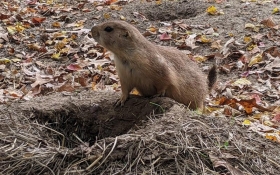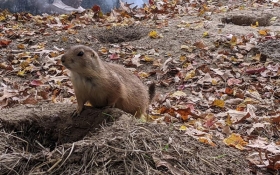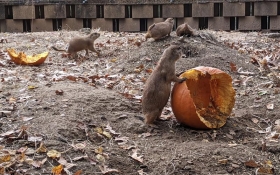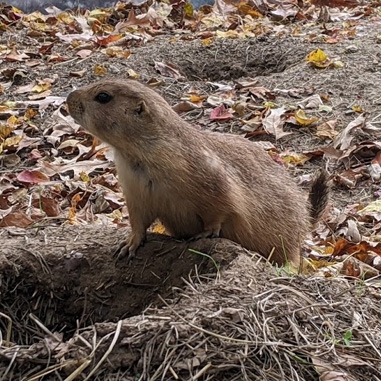
Prairie Dog
Cynomys ludovicianus
Animal Behavior: Prairie dogs are the most social of the ground- dwelling sciurids. Prairie dog colonies, or towns, may contain hundreds of individuals living within a very restricted area. (The largest colony ever recorded occurred in Texas. It covered an area of 65,000 km^2 and contained and estimated 400 million of animals.) Within the town there are certain neighborhoods, or coteries. Females typically remain in their natal coterie, whereas males disperse to a nearby coterie. Each coterie is populated by a group of closely related females (sister, mothers, aunts) and one or two territorial males. When multiple males are found in a single coterie, they are often brothers. Territories are defended aggressively from neighbors. Prairie dogs have long been noted for their highly social behavior. There is often playing, muzzling, mutual grooming, and a great deal of vocal communication. For instance, when a prairie dog spots a predator, such as a hawk, badger or black-footed ferret, it raises an alarm call, alerting its neighbors. All of the prairie dogs hearing this cry quickly scuttle into their burrows for protection.
Eating Habits: Black-tailed prairie dogs eat primarily leaves, stems, and roots of grasses, weeds, and forbs. Although vegetable matter comprises over 98% of the diet, animal matter may somteimes be ingested. The animals typically eaten by prairie dogs are grasshoppers, cutworms, bugs, and beetles. Black-tailed prairie dogs do not need to drink water in order to get the moisture they need to survive. They obtain all the moisture they need from their moist, leafy foods. Most prairie dogs forage close to their burrows when possible, moving into distant foraging areas only when forced to do so by local shortages of green shoots.
Range: Common warthogs are found in open and wooded savannas, grass-steppes, and semi-deserts in Africa. Common warthogs prefer open areas and avoid rainforest and severe desert. They are found on Kilimanjaro up to an elevation of 3000 m and along coastal regions of Africa. Common warthogs often utilize formerly wooded areas that have been cleared for pastures.
Conservation Efforts: Historically, prairie dogs were vilified by ranchers, and efforts were made to eradicate entire populations. Although not as common as they once were, many prairie dog colonies persist in protected areas.
